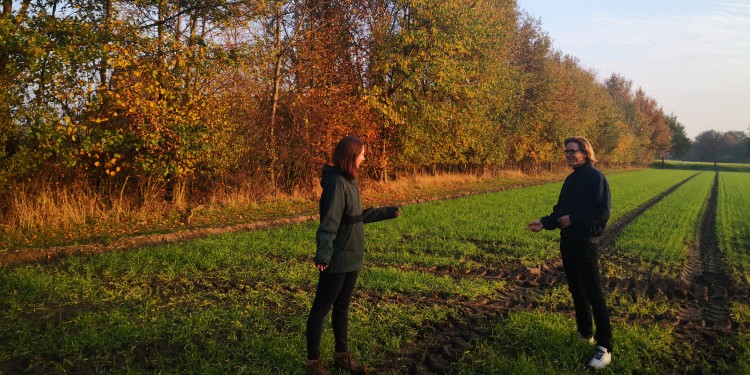
More sustainability on farmland
Agriculture has significant impacts on the environment, nature, soils and biodiversity. Figures published by the German Ministry of Food and Agriculture in 2018 showed that more than 50 percent of the land is used for agriculture. Today, the biological, economic and social consequences predicted by ecological scientists are already visible. Students of landscape ecology Julia Binder and Thomas Middelanis have initiated a project entitled “Meeting points for agriculture, civil society and science: monitoring modern agroforestry ecosystems”, and their aim is to design agricultural areas in a more sustainable way through ‘agroforestry’. By cultivating woody plants, the idea is to produce synergies between agricultural use and integrating such woody plants and, at the same time, take into account conservation requirements. The aim is to build up a collaborative network between science and local stakeholders in several regions in Germany in which farmers have converted their land to agroforestry systems.
“We avoid any methods and experiments unrelated to practical work and rely instead on comprehensive data acquisition through the involvement of citizens,” Thomas Middelanis explains. “Citizen Science plays an important role for us,” adds Julia Binder. “Our aim is to bring people into contact with nature and agriculture.” The two master’s students, both 24 years old, quickly found other people to join their project. The interdisciplinary research group already consists of 16 students from the Universities of Münster, Bonn and Rhein-Waal University of Applied Sciences in Cleves – even though the project only officially got going in February. “We’re very enthusiastic about the project,” says Middelanis. “We phone each other up all times of day and night because we constantly have new ideas.”
With their victory in the 2020 “Münster University Citizen Science Competition” and the support it entailed of 7,500 euros, Binder and Middelanis were able to lay the financial foundation for the next two years. Prof. Tillmann Buttschardt from Münster University’s Institute of Landscape Ecology is lending his scientific expertise to the project, as are experts from the Universities of Gießen, Göttingen and Bonn and Rhein-Waal University of Applied Sciences.
“This initiative is a good example of how learning through research can be successful in university teaching,” says Tillmann Buttschardt. “At the moment, agroforestry systems are of no great importance for farmers, apart from a small group of them. However, such systems will become increasingly important in future, simply because of necessary adaptations to climate change.”
The cultivation and use of woody plants on agricultural areas have a long tradition in Europe. Examples of this are meadow orchards in Germany or the cork-oak and olive groves in Mediterranean countries. Over the past decades, however, this way of using the land has declined. The reason is the mechanization and industrialization of agriculture since the 20th century. In view of the tangible periods of drought, the ongoing decline in biodiversity and the necessary storage of carbon dioxide (CO2), agroforestry is experiencing a new upswing.
This is where the project kicks in. The first phase creates the bases for future research: in their master’s module “Landscape usage and management” in this semester, the students are drawing up a catalogue of methods and some campaigns for terrains so that, using relevant parameters, they can study the fast-growing strips of trees and woody plants on the farmland and their long-term use. After that, probably in August, there are plans for workshops and info events on the six participating farms for anyone interested, as well as for conservation groups and school classes. The farms collaborating in the project are in the Tecklenburg Region, Lüneburg, the Barkau Region in the State of Schleswig-Holstein, at the Baltic Sea, in Western Pomerania and in the Altmark Region in the State of Saxony-Anhalt.
On their research trip, the students aim to set up local groups who will record data on site. After an evaluation of the first results – and, if necessary, adjustments to the catalogue of methods – the second project phase, set to start in spring 2022, will see data acquisition at the six sites. Evaluation and presentation of the data will be undertaken by students from the Institute of Landscape Ecology at Münster University.
The local collaborative network is a long-term project in which changes to the agroforestry systems will be observed – on the basis of criteria drawn up by those involved – and then collated. Setting up a freely accessible database is also under consideration. “We see the exchange of agricultural knowledge as a key path towards shaping our cultural landscape in a sustainable way,” Julia Binder explains.
Author: Kathrin Nolte
This article was first published in the University newspaper wissen|leben No. 3, 19 May 2021.
